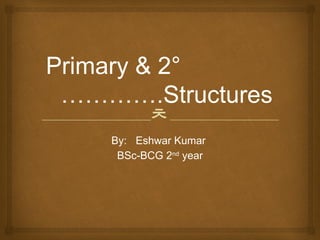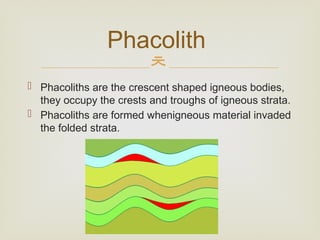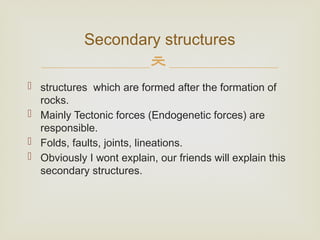Primary structures geology
- 1. Primary & 2° ………….Structures By: Eshwar Kumar BSc-BCG 2nd year
- 2. Any definable shape/fabric in a rock body. It is a large scale feature. easily noticed. Divided into :- 1)Primary structures 2)secondary structures What is a structure?
- 3. Structures that are developed during formation of rock, or shortly after formation. Non tectonic forces (exo genetic forces are responsible) Mainly show the direction of flow of the forming agent.( wind, water, ice etc ) Primary structures
- 4. Beds Lamination Cross bedding Graded bedding Ripple marks Mud cracks Rain prints Trail and tracks Concreations Unconformity Sedimentary primary structures
- 5. According to law of uniformitarianism, sediments will accumulate horizontally while getting deposited. Bedding is a planar arrangement of particles which can be easily distinguished by difference in color, composition and texture. ≥ 1cm in thickness. Lamination is a term used if particles arrange themselves same as bedding but their thickness is less than 1 cm. Bedding and lamination
- 7. It is formed on tilted surface during deposition by crossing a bed to another one. It is in between topmost bed and fore set bed. Indicates the direction of the paleocurrents. Cross bedding
- 9. It is bedding in which the particles are sorted according to density, size and shape. Particles in water settle at different rates depending on size, density and shape. forming "graded bed" with layers of coarse material deposited first and finer grains deposited later. Normal and reverse grading are the types. Graded bedding
- 11. Are wavy undulating features formed by wind, wave or current. Indicate the ancient and modern sedimentary environment. Formed in shallow waters. Also show the direction of flow.(Asymmetric ripples) Divided into :- symmetric and asymmetric. Ancient ripple marks preserved as casts. Ripple marks
- 13. Mud cracks are often found in the fine grained sedimentary rocks that has been exposed to drying under subaerial conditions. They form a network of fissures enclosing polygonal areas. Indicate once present water body. Ancient mudcracks preserved as casts. Mudcracks
- 15. A rain print is a slight shallow depression rimmed by a low ridge which is raised by the impact of rain drops. It is formed when a brief rain shower falls on a smooth fine grained sediment. Rain prints
- 16. Trails and tracks are the markings indicating the passage of some animals over the soft sediment. Trails and tracks
- 17. Are variously shaped masses or nodules of mineral matter found within a sedimentary rock. They are formed by the deposition of the perlocating mineral solution. Concretions
- 18. Major breaks in sedimentation is called unconformity Simply put any observable difference indicating the gap in sedimentation. hiatus 4 types:- Angular unconformity Disconformity Non conformity paraunconformity Unconformity
- 20. Dykes Sills Batholith Laccolith Lopolith Phacolith Pillow lava Ropy lava and blocky lava Pyro clastic flows Columnar joints Vesicular and amygdaloidal Igneous primary structures
- 21. Dyke (dike) is discordant, or cross cutting, tabular intrusion, usually igneous in origin, Vertical or nearly vertical, having pushed the country rock way and generally harder than them. Dykes
- 22. Sills also called sheet, flat intrusion of igneous rock that forms between preexisting layers of rock generally concordant with the bedding planes of the surrounding rocks. Sill
- 23. A batholith is a large mass of intrusive igneous rock, larger than 100 square kilometres in area, that forms from cooled magma deep in the Earth's crust. Batholiths are almost always made mostly of felsic or intermediate rock types, such as granite.. Batholith
- 24. A laccolith is a lens shaped(mushroom shaped) intrusive igneous body which causes the overlying bed to arch in the shape of a dome. laccolith
- 25. A lopolith is a saucer shaped(bowl shaped) igneous body which is bent in downward into a basin like shape. lopolith
- 26. Phacoliths are the crescent shaped igneous bodies, they occupy the crests and troughs of igneous strata. Phacoliths are formed whenigneous material invaded the folded strata. Phacolith
- 27. Pillow lavas are lavas that contain characteristic pillow-shaped structures that are attributed to the extrusion of the lava under water, or subaqueous extrusion. Pillow lavas are commonly of basaltic composition. Pillow lava
- 28. Ropy or pahoehoe lava is a lava marked with smooth wrinkles resembling rope. Blocky or Aa lava has solid chunks formed due to rapid flow and rapid cooling. Ropy and blocky lava
- 29. Volcanic products form these Volcanic breccia: >4mm and angular clasts. Agglomerate: rounded fragments >4mm Tuff : <4mm Ash flows or ignimbrite: Very very fine. Pyroclastic flows
- 31. Columnar jointing is a geological structure where sets of intersecting closely spaced fractures, referred to as joints, result in the formation of a regular array of polygonal prisms, or columns. These form when igneous material comes out from restricted zones and cools down. Columnar joints
- 32. Gas cavities which are formed due to escaping of volatiles in a igneous rock manifests vesicular structure. When these vesicles get filled with secondary minerals ,it forms Amygdaloidal structure. Vesicular and Amygdaloidal
- 33. structures which are formed after the formation of rocks. Mainly Tectonic forces (Endogenetic forces) are responsible. Folds, faults, joints, lineations. Obviously I wont explain, our friends will explain this secondary structures. Secondary structures
- 34. Eat well Do regular exercise Invest time in studies Strict hand washing is compulsory. Follow the precautions issued by government. As we are living through a historic moment ourselves lets stand united and stay home. #STAY HOME STAY SAFE# Hope everyone is taking care of themselves

































